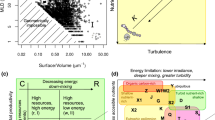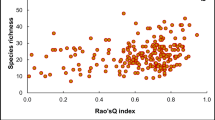Abstract
In Science we cannot say that `the exception proves the rule'. We have been looking to define patterns in phytoplankton occurrence across trophic spectra where conspicuous covariations between algae and trophic states have been reported. We consider quite different phytoplankton communities observed under similar trophic conditions: we illustrate this point by considering five different phytoplankton communities living in five water bodies in the same wetland, along a TP gradient and over a period of 2 years. This system showed a remarkable dissimilarity of species representation, implying communities of uncorrelated species vary considerably over time. Despite the presence of some characteristic species, communities were not related to a given trophic state. However, coarser community attributes, such as clusters of taxonomic classes, appeared to be more useful in identifying patterns and assembly rules related to trophic spectra. Some ecological concepts can be related to this lack of pattern, e.g., nonconvergence, trajectories far from equilibrium and assembly rules of communities.
Similar content being viewed by others
References
Alvarez-Cobelas, M. & S. Cirujano (eds), 1996. Las Tablas de Daimiel, Ecología Acuájtica y Sociedad. Organismo Autónomo de Parques Nacionales, Madrid, 368 pp.
Bunge, M., 1975. La Investigación Cientifíca. Su estrategia y su filosofía. Ariel, Barcelona, 955 pp.
Drake, J. A., 1990a. Communities as assembled structures: Do rules govern pattern? TREE 5: 159–164.
Drake, J. A., 1990b. The mechanics of community assembly and succession. J. theor. Biol. 147: 213–233.
Legendre, L. & P. Legendre, 1979. Ecologie Numerique, 1: Le Traitament Multiple des Données Ecologiques. Masson, Paris, 247 pp.
Lund, J. W. G., C. Kipling & E. D. LeCren, 1958. The inverted microscope method of estimating algal numbers and the statistical basis of estimations by counting. Hydrobiologia 11: 143–170.
Mulamoottil, G., B. G. Warner & E. A. McBean, 1996. Wetlands. Environmental Gradients, Boundaries, and Buffers. Lewis Publishers, Boca Raton, FL, 298 pp
Padisák, J., 1992. Seasonal succession of phytoplankton in a large, shallow lake (Balaton, Hungary): a dynamic approach to ecological memory, its possible role and mechanisms. J. Ecol. 80: 217–230.
Pielou, E. C., 1974. Population and Community Ecology. Gordon & Breach, New York.
Reynolds, C. S., 1996. Plant life of the pelagic. Verh. int. Ver. Limnol. 26: 97113.
Reynolds, C. S., 1997. Vegetation Processes in the Pelagic: a Model for Ecosystem Theory. Excellence in Ecology Books. Ecology Institute, Oldendorf, 371 pp.
Reynolds, C. S., 1998. What factors influence the species composition of phytoplankton in lakes of different trophic status?. Hydrobiologia 369/370 (Dev. Hydrobiol. 129): 11–26.
Rojo, C., 1996. Fitoplancton. In Alvarez-Cobelas, M. & S. Cirujano (eds), Las Tablas de Daimiel. Ecología Acuática y Sociedad. Organismo Autónomo de Parques Nacionales, Madrid: 107–116.
Rojo, C., 1998. Differential attributes of phytoplankton across the trophic gradient: a conceptual landscape with gaps. Hydrobiologia 369/370 (Dev. Hydrobiol. 129): 1–9.
Rojo, C. & M. Alvarez-Cobelas, 1993. Hypertrophic phytoplankton and Intermediate Disturbance Hypothesis. Hydrobiologia 249 (Dev. Hydrobiol. 81): 43–58
Rojo, C. & J. Rodriguez, 1994. Seasonal variability of phytoplankton size structure in a hypertrophic lake. J. Plankton Res. 16: 317–335.
Rojo, C., E. Ortega-Mayagoitia & V. Conforti, 1999. Fitoplancton del Parque Nacional de Las Tablas de Daimiel. 1. Las euglenofitas. An. Jard. Bot. Madrid 57(1): 15–23.
Samuels, C. & J. A. Drake, 1997. Divergent perspectives on community convergence. TREE 12: 427–432.
Seip. K. L. & C. Reynolds, 1995. Phytoplankton functional attributes along trophic gradient and season. Limnol. Oceanogr. 40: 589–597.
Sneath, P. H. A. & R. R. Sokal, 1973. Numerical Taxonomy. Freeman, San Francisco, 573 pp.
Van der Steen, W. J., 1993. A Practical Philosophy for the Life Sciences. State University of New York Press, Albany, 208 pp.
Weiher, E. & P. A. Keddy, 1995. Assembly rules, null models, and trait dispersion: new questions from old patterns. Oikos 74: 159–164.
Author information
Authors and Affiliations
Rights and permissions
About this article
Cite this article
Rojo, C., Ortega-Mayagoitia, E. & Alvarez-Cobelas, M. Lack of pattern among phytoplankton assemblages. Or, what does the exception to the rule mean?. Hydrobiologia 424, 133–139 (2000). https://doi.org/10.1023/A:1003917414959
Issue Date:
DOI: https://doi.org/10.1023/A:1003917414959




